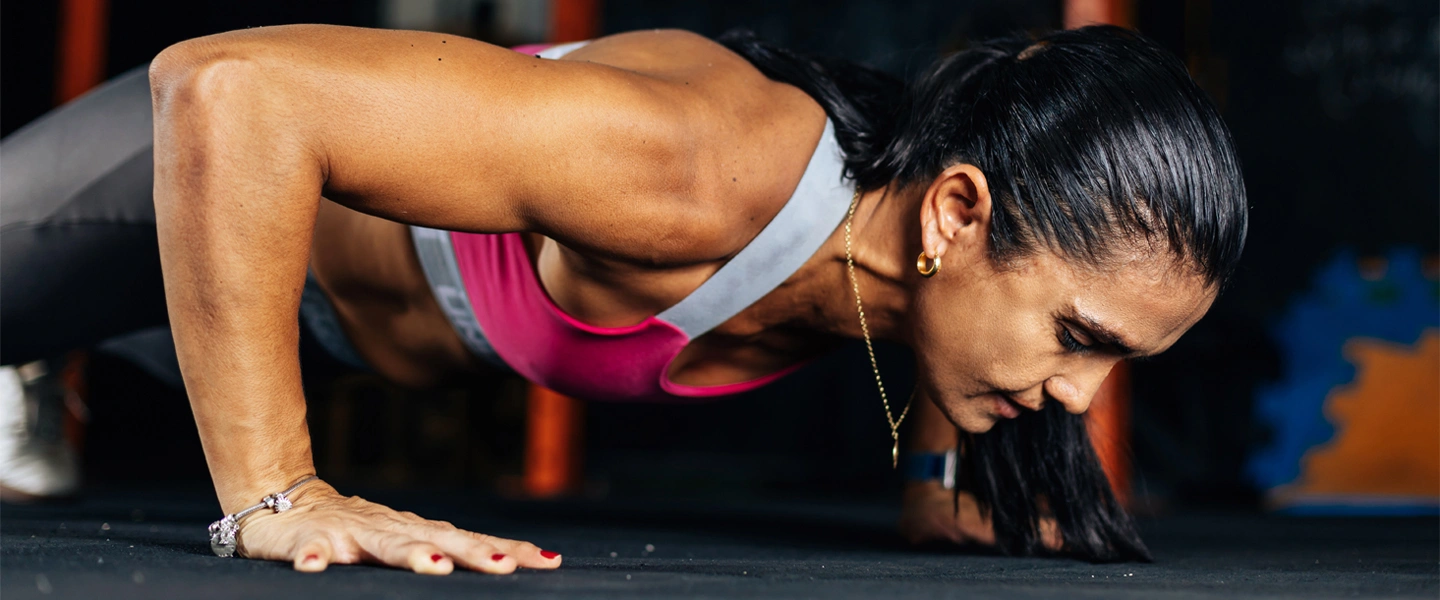- Muscle Mass Matters As Women Age: Women naturally lose muscle with age, especially during and after menopause, making muscle preservation a key health concern.
- Hormones Directly Influence Muscle Strength: Estrogen and testosterone play critical roles in muscle maintenance, and their decline can lead to accelerated muscle loss.
- Hormone Therapy Options Are Varied And Personalized: Hormone therapy comes in different forms—like estrogen-only or combination therapies—and is tailored to each woman's needs.
- Hormone Therapy Can Help Preserve Muscle Mass: Research shows hormone therapy can support muscle retention by boosting protein synthesis and reducing muscle breakdown.
- Estrogen Protects Muscles In Multiple Ways: Estrogen supports muscle repair and mitochondrial function, helping women retain strength and energy.
- Testosterone Also Supports Strength In Women: Low-dose testosterone therapy can support muscle tone, sex drive and energy. When used under expert supervision, it can be a safe and highly effective part of a comprehensive hormone plan.
- Lifestyle Factors Enhance Hormone Therapy's Effects: Exercise, protein-rich diets, and quality sleep work synergistically with hormone therapy for optimal muscle maintenance.
- Some Women See Real Improvements With Hormone Therapy: Women on hormone therapy may notice better stamina, less fatigue, and preserved muscle when therapy is started early and managed carefully.
- Hormone Therapy May Be Part Of Your Muscle Health Plan: Hormone therapy is one of the most effective ways to protect muscle, energy, and strength through midlife and beyond. When started early and managed correctly, it can be life-changing.
As women age, maintaining strength becomes less of a fitness goal and more of a health priority. Muscle mass naturally declines over time, and for women, the transition into menopause often accelerates this process.
But what if there was a way to help slow that loss and even preserve lean muscle? That's where hormone therapy enters the conversation.
If you've ever wondered, "Does hormone therapy change muscle mass?", you're not alone. Let's break down what the science says, how hormones influence muscle, and what hormone therapy can (and can't) do to help women stay strong throughout midlife and beyond.

Why Muscle Mass Matters for Women
Muscle isn't just about appearance or athleticism. It's essential for everyday function, metabolism, bone health, and even insulin sensitivity.
Unfortunately, starting around age 30, muscle mass begins to decline at a rate of 3-8% per decade (1). This process, called sarcopenia, can speed up rapidly during and after menopause. For many women, this leads to weight gain and body composition changes, slower metabolism, and increased fatigue.
It can even lead to dangerous side effects like decreased mobility and a higher risk of falls or fractures. Hormones, especially estrogen, play a major role in regulating muscle mass. So when estrogen levels drop, muscle maintenance becomes harder.
That's why hormone therapy is gaining attention as a potential strategy to support strength and vitality in midlife women.
The Link Between Hormones And Muscle Mass In Women
Hormones act like messengers in the body by coordinating countless systems, including how we build and maintain muscle. For women, two hormones in particular, estrogen and testosterone, play outsized roles in muscle health, even though their connection to muscle function is often underrecognized compared to their reproductive functions (2).
The Influence of Estrogen
Estrogen plays a far more complex and essential role in the body than simply regulating reproductive health. In fact, when it comes to muscle function and strength, estrogen is a quiet but powerful contributor. Its influence begins at the cellular level and extends to how we move, recover, and perform on a daily basis.
One of estrogen's most important functions is regulating inflammation, particularly after physical activity. When we exercise, our muscles experience microscopic tears, a normal and necessary part of building strength. Estrogen helps moderate the body's inflammatory response, ensuring that this repair process happens smoothly without tipping into excessive inflammation, which can delay healing and increase soreness.
In addition to managing inflammation, estrogen directly supports muscle repair. It does this by influencing the activation of satellite cells, specialized muscle stem cells responsible for regenerating and rebuilding damaged muscle fibers. When estrogen levels are adequate, this repair process works more efficiently, allowing for better recovery and, over time, improved muscle maintenance.
Estrogen also has a significant effect on metabolism. It helps muscle cells more effectively use glucose (sugar) and fatty acids for fuel, which impacts both how much energy you have during workouts and how well your muscles function at rest. When estrogen declines, this metabolic efficiency often drops as well, which can lead to fatigue, decreased endurance, and unwanted changes in body composition.
Perhaps most critically, estrogen enhances the function of mitochondria, the energy-producing structures inside cells. In muscle tissue, healthy mitochondrial activity translates to more stamina, better energy output, and increased resilience during physical exertion. Estrogen essentially helps your muscle cells work smarter and harder.
Some evidence also suggests that estrogen may influence neuromuscular coordination, contributing to smoother movements and better balance. This may help explain why some women experience increased clumsiness or a higher risk of falls during and after menopause, when estrogen levels plummet.
The Role Of Testosterone
Though often labeled a "male hormone," women also produce testosterone, albeit in smaller amounts. In fact, testosterone plays an essential role in stimulating muscle protein synthesis (the process that builds and repairs muscle fibers); maintaining bone density and strength; and enhancing motivation and physical drive, which can influence activity levels and consistency in workouts.
Even small declines in testosterone (which often occur alongside estrogen declines during menopause) can lead to noticeable differences in muscle tone, athletic performance, and energy.
What Happens During Menopause
During perimenopause and menopause, estrogen and testosterone production decline significantly. For many women, this hormonal shift leads to a drop in lean muscle mass (3), increased fat storage (especially around the abdomen), more difficulty building strength or recovering from workouts, greater fatigue and less physical motivation.
Coupled with natural aging, decreased physical activity, or dietary shifts (such as lower protein intake), this can accelerate a downward spiral of muscle loss—sometimes without women even realizing it's happening. You may still be active, but you're working harder to maintain less.
What Is Hormone Therapy?
Hormone therapy is a medical treatment designed to supplement or replace the hormones your body no longer produces in sufficient quantities—most commonly estrogen and progesterone.
There are three main types of hormone therapy:
- Estrogen therapy (ET): Usually prescribed to women who have had a hysterectomy.
- Estrogen plus progestin therapy (EPT): For women with a uterus, progestin is added to reduce the risk of uterine cancer.
- Bioidentical hormone therapy: Hormones that are chemically identical to those your body produces, often derived from plant sources. These are available through prescription and compounded therapies.
Hormone therapy is most commonly used to treat symptoms of menopause, including hot flashes, night sweats, and vaginal dryness. But an increasing body of research suggests it may also play a role in preserving muscle mass—especially when started during the early stages of menopause (4).
Does Hormone Therapy Change Muscle Mass?
This is the big question and the research says yes, hormone therapy can affect muscle mass.
Multiple studies suggest that hormone therapy, especially estrogen-based therapy (4), may help maintain or even slightly increase lean muscle mass in postmenopausal women. While HT isn't a substitute for exercise or nutrition, it can influence the underlying biological processes that preserve muscle.
How Hormone Therapy May Help:
- Increases Muscle Protein Synthesis: Estrogen may enhance the body's ability to rebuild muscle tissue.
- Reduces Muscle Breakdown: Hormone therapy can help limit catabolic (breakdown) activity in muscle cells.
- Improves Physical Function: Some studies show women on hormone therapy perform better in physical strength and endurance tests than those who are not.
- Preserves Lean Body Mass: While not dramatic, the difference is often meaningful—especially when combined with strength training.
It's important to note that results vary based on when hormone therapy is started, how long it's used, and individual health factors. Women who begin hormone therapy within a few years of menopause tend to see the best outcomes.
Hormone Therapy Versus Natural Strategies For Muscle Preservation
Hormone therapy isn't a magic solution, but it can work in synergy with natural strategies to help women stay strong.
Proven Lifestyle Strategies:
- Strength Training: Resistance-based workouts stimulate muscle growth and help preserve lean tissue.
- Protein-Rich Diet: Adequate protein is essential for muscle repair. Women over 40 should aim for 1.2-1.6 grams per kilogram of body weight daily.
- Sleep And Stress Management: Recovery happens during rest. Chronic stress and poor sleep can elevate cortisol, which breaks down muscle.
- Vitamin D And Omega-3s: These nutrients also support muscle function and hormonal balance.
Hormone therapy can make these efforts more effective. For example, estrogen helps make muscles more responsive to resistance training. That's why a combined approach, hormone therapy plus exercise and nutrition, often delivers the best results.

Risks, Benefits, and Considerations
For most healthy women in their 40s, 50s, and into their 60s, the benefits of bioidentical hormone therapy far outweigh the risks. When started within 10 years of menopause or before age 60, modern hormone therapy is considered safe and highly effective for protecting long-term health (Stuenkel et al., 2022).
Possible Risks:
- With properly prescribed bioidentical hormones, risks such as blood clots, stroke, or heart disease are negligible in healthy women
- The small potential increase in breast cancer risk with long-term use is lower than the everyday risks many women already accept, such as drinking a single glass of wine daily
- Temporary side effects like breast tenderness, bloating, or mood changes can occur but are usually mild and improve with time
Important Considerations:
The safest and most effective therapy depends on your individual needs, and your provider will help determine the right approach for you
Work with a provider who understands your personal health history and can tailor treatment to your needs
What To Expect
So, what does all this look like in everyday life?
Many women report that once they start hormone therapy, they feel more energized, less achy, and more capable during workouts. They often regain confidence in their bodies, especially when paired with regular strength training and a supportive routine.
Improvements may include:
- Better stamina and endurance
- Easier recovery from exercise
- Less joint discomfort and fatigue
- A subtle but meaningful increase in muscle tone
However, these changes aren't instant. Hormone therapy works gradually, and benefits often accumulate over several months. Setting realistic expectations, and maintaining consistent habits, makes all the difference.
Should You Consider Hormone Therapy For Muscle Health?
If you've found yourself struggling with unexplained fatigue, decreased muscle tone, or slower recovery, hormone changes could be playing a role. And if you're in the menopausal transition or postmenopausal, hormone therapy might be worth exploring.
So, does hormone therapy change muscle mass? The answer is yes, but not in the way a bodybuilder might expect. Instead of creating new muscle out of thin air, hormone therapy helps preserve what you already have. It keeps the door open for strength, stamina, and long-term mobility.
Whether or not hormone therapy is right for you depends on your individual health, goals, and comfort level. But it's a conversation worth having, with a provider who understands the nuances of women's hormonal health.
Your Next Step: Talk to an Expert
At Fem Excel, we specialize in helping women navigate hormonal changes with confidence. If you're curious about hormone therapy, muscle health, or how to feel stronger in your 40s, 50s, and beyond, we're here to help.

Get HRT Online
Optimize Your Hormones
References:
[1] Volpi E, Nazemi R, Fujita S. Muscle tissue changes with aging. Curr Opin Clin Nutr Metab Care. 2004 Jul;7(4):405-10. doi: 10.1097/01.mco.0000134362.76653.b2. PMID: 15192443; PMCID: PMC2804956.
[2] Osmancevic, O, et al. Exploring the relationships between sex hormones and abdominal muscle area and radiodensity in postmenopausal women. 2025 March. https://doi.org/10.1016/j.maturitas.2025.108197
[3] Ko J, Park YM. Menopause and the Loss of Skeletal Muscle Mass in Women. Iran J Public Health. 2021 Feb;50(2):413-414. doi: 10.18502/ijph.v50i2.5362. PMID: 33748008; PMCID: PMC7956097.
[4] Tiidus PM. Benefits of estrogen replacement for skeletal muscle mass and function in post-menopausal females: evidence from human and animal studies. Eurasian J Med. 2011 Aug;43(2):109-14. doi: 10.5152/eajm.2011.24. PMID: 25610174; PMCID: PMC4261347.
[5] Stuenkel CA, et al. Treatment of Symptoms of the Menopause: An Endocrine Society Clinical Practice Guideline. J Clin Endocrinol Metab. 2022;107(4):984-1002. doi:10.1210/clinem/dgab904 https://pubmed.ncbi.nlm.nih.gov/26444994/





